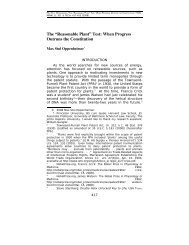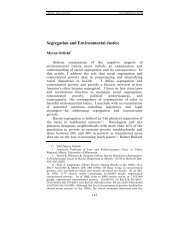An Organizational Approach to the Design of Patent Law
An Organizational Approach to the Design of Patent Law
An Organizational Approach to the Design of Patent Law
You also want an ePaper? Increase the reach of your titles
YUMPU automatically turns print PDFs into web optimized ePapers that Google loves.
6 VERTINSKY FINAL_JAD (DO NOT DELETE) 2/27/2012 2:20 PM<br />
2012] AN ORGANIZATIONAL APPROACH 275<br />
are particularly effective, or ineffective, at producing and utilizing<br />
new technologies and investigating what role, if any, patents<br />
play in sustaining those structures may <strong>of</strong>fer new insights<br />
in<strong>to</strong> <strong>the</strong> impact <strong>of</strong> patent law on innovation. Theories <strong>of</strong><br />
knowledge management and spillover can be used <strong>to</strong> study <strong>the</strong><br />
interaction between incumbent firms and entrepreneurs in <strong>the</strong><br />
presence and absence <strong>of</strong> intellectual property rights. 270 A particularly<br />
fruitful avenue for exploring <strong>the</strong> intersection <strong>of</strong> intellectual<br />
property and entrepreneurship lies in <strong>the</strong> study <strong>of</strong> organizational<br />
responses <strong>to</strong> opportunities and obstacles in<br />
cumulative innovation. Examples include <strong>the</strong> study <strong>of</strong> how <strong>the</strong><br />
conditions surrounding <strong>the</strong> access and use <strong>of</strong> an innovation impact<br />
<strong>the</strong> ability <strong>of</strong> o<strong>the</strong>rs <strong>to</strong> innovate cumulatively. 271 Industrial<br />
organization and game <strong>the</strong>ory can help in exploring <strong>the</strong> effects<br />
<strong>of</strong> changing market structures on entrepreneurship. The expansion<br />
<strong>of</strong> markets for technology may, for example, ei<strong>the</strong>r enhance<br />
<strong>the</strong> development <strong>of</strong> new ventures by providing greater<br />
access <strong>to</strong> new technologies with commercial potential, or reduce<br />
it by pushing innova<strong>to</strong>rs <strong>to</strong> sell early <strong>to</strong> large purchasers ra<strong>the</strong>r<br />
than accept <strong>the</strong> risk <strong>of</strong> self-development. Comparisons can be<br />
drawn between <strong>the</strong> ability <strong>of</strong> big and small firms <strong>to</strong> innovate<br />
and <strong>the</strong> potential costs <strong>of</strong> hierarchy and size in limiting entrepreneurial<br />
activity, and this can be tied <strong>to</strong> <strong>the</strong> roles that patents<br />
may play in allowing or impeding efforts <strong>to</strong> spin <strong>of</strong>f ideas<br />
and create new ventures or, conversely, <strong>to</strong> block <strong>the</strong> development<br />
<strong>of</strong> competing technologies. 272 This type <strong>of</strong> research can be<br />
used <strong>to</strong> provide <strong>the</strong> contextual framework within which <strong>to</strong><br />
reexamine <strong>the</strong> implications <strong>of</strong> existing studies within <strong>the</strong> pa-<br />
270. See, e.g., Zoltan J. Acs, Pontus Braunerhjelm, David B. Audretsch &<br />
Bo Carlsson, The Knowledge Spillover Theory <strong>of</strong> Entrepreneurship, 32 SMALL<br />
BUS. ECON. 15, 15–19 (2009) (looking at <strong>the</strong> source <strong>of</strong> entrepreneurial opportunities<br />
and tying it <strong>to</strong> knowledge and ideas created in incumbent organizations,<br />
and suggesting that entrepreneurial opportunities are not exogenous<br />
but instead systematically created by investments in knowledge); Zoltan J. Acs<br />
& Mark Sanders, Intellectual Property Rights and <strong>the</strong> Knowledge Spillover<br />
Theory <strong>of</strong> Entrepreneurship § I (Jena Econ. Res. Papers, Paper No. 2008–069,<br />
2008), available at http://edoc.mpg.de/get.epl?fid=52283&did=399807&ver=0<br />
(arguing that, up <strong>to</strong> a point, stronger IP rights may facilitate entrepreneurship,<br />
but at some point, expanding IP rights may dampen <strong>the</strong> incentives <strong>of</strong> entrepreneurs).<br />
271. See, e.g., Fiona Murray & Siobhán O’Mahony, Exploring <strong>the</strong> Foundations<br />
<strong>of</strong> Cumulative Innovation: Implications for Organization Science, 18<br />
ORG. SCI. 1006, 1006–07 (2007); J. H. Reichman, Of Green Tulips and Legal<br />
Kudzu: Repackaging Rights in Subpatentable Innovation, 53 VAND. L. REV.<br />
1743, 1744–45 (2000).<br />
272. See generally Sichelman & Graham, supra note 256.






